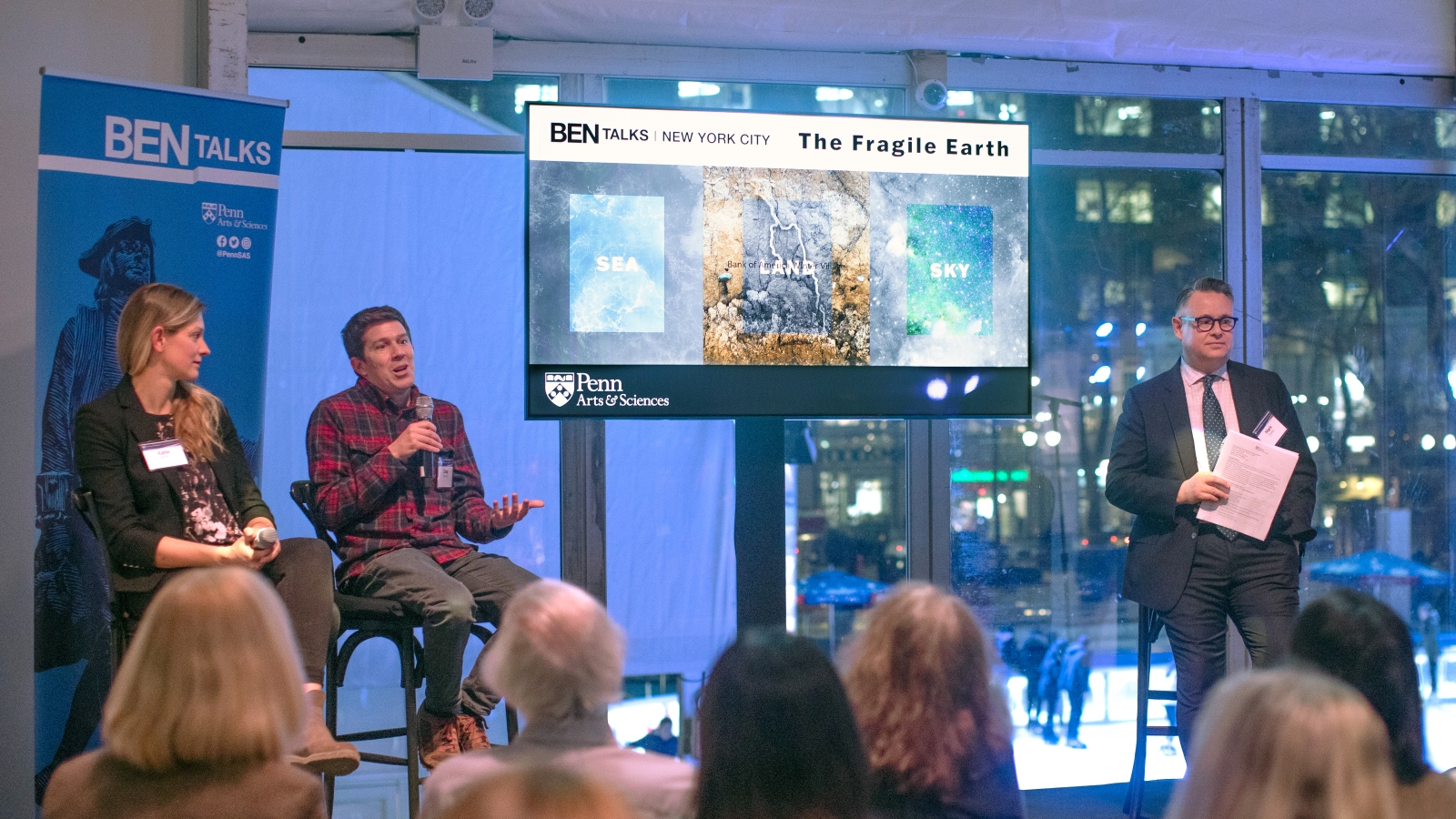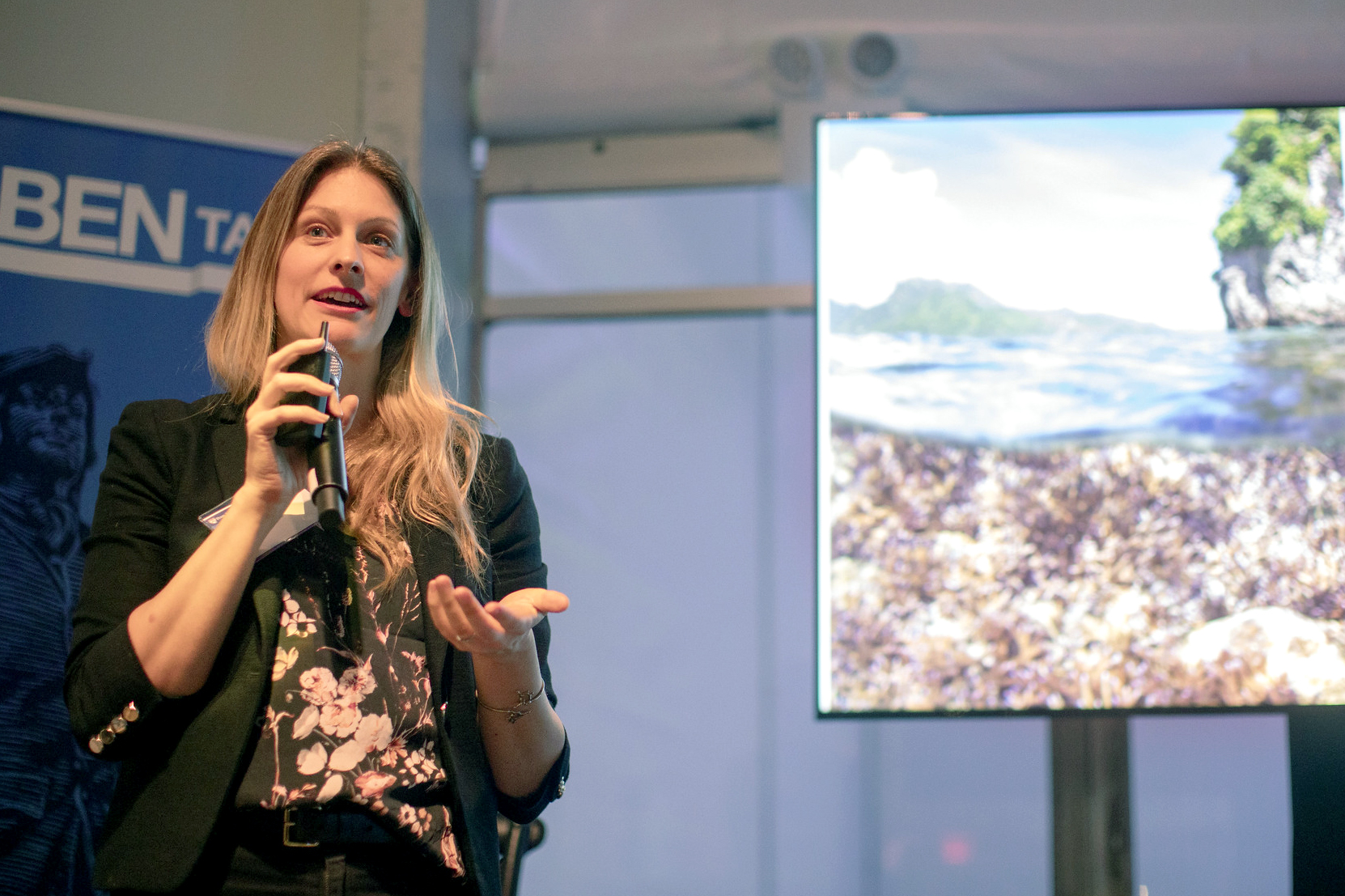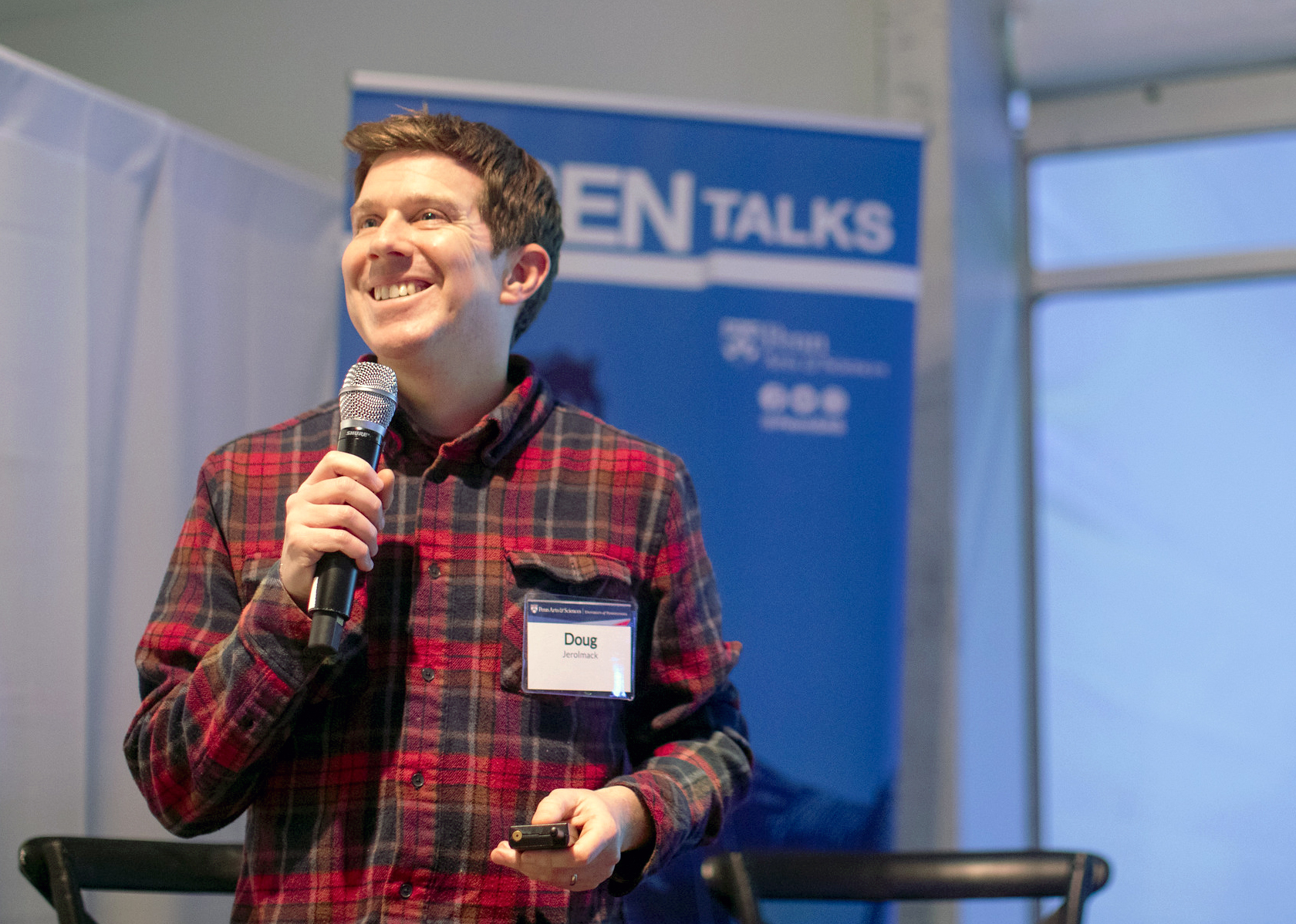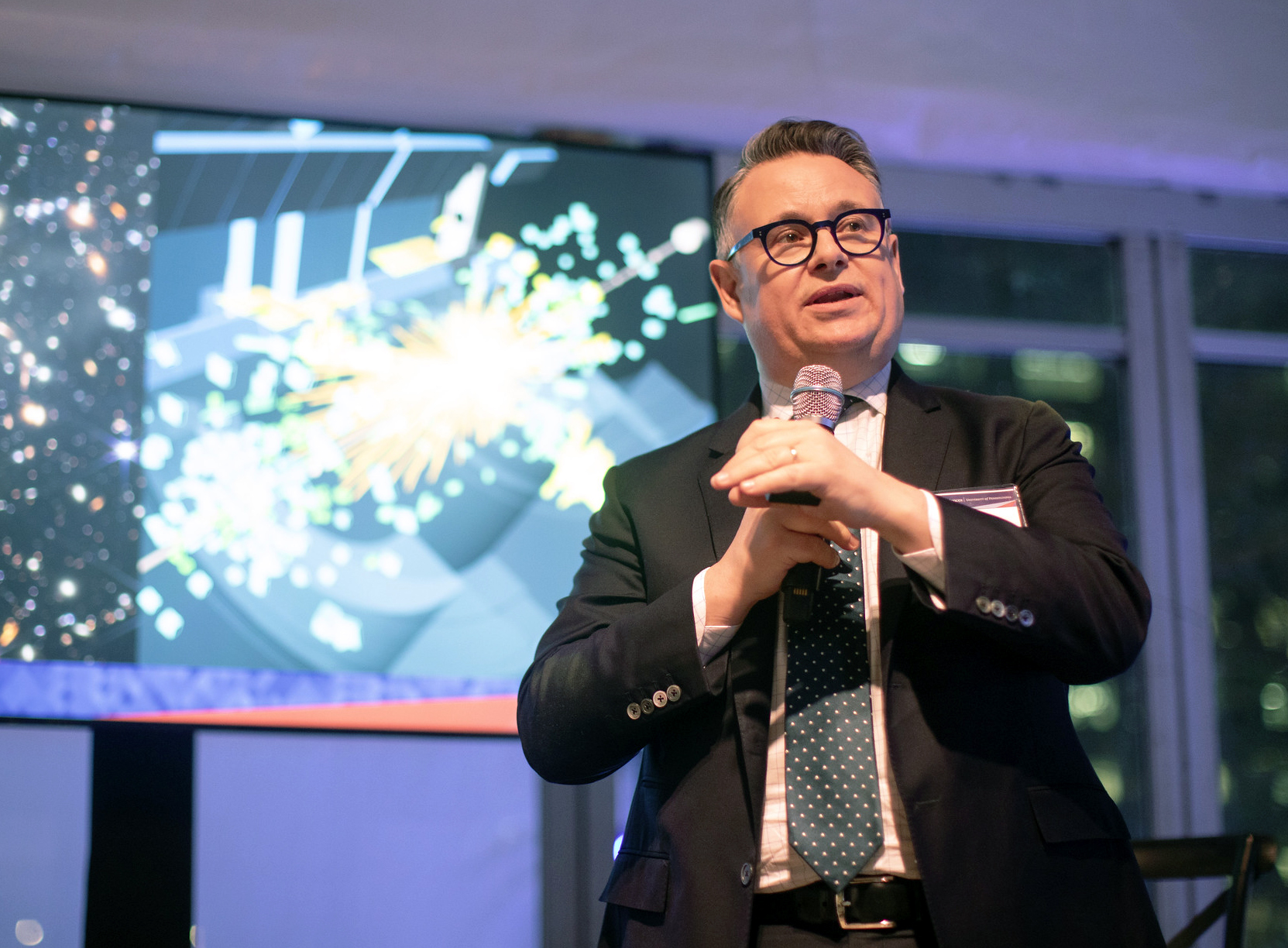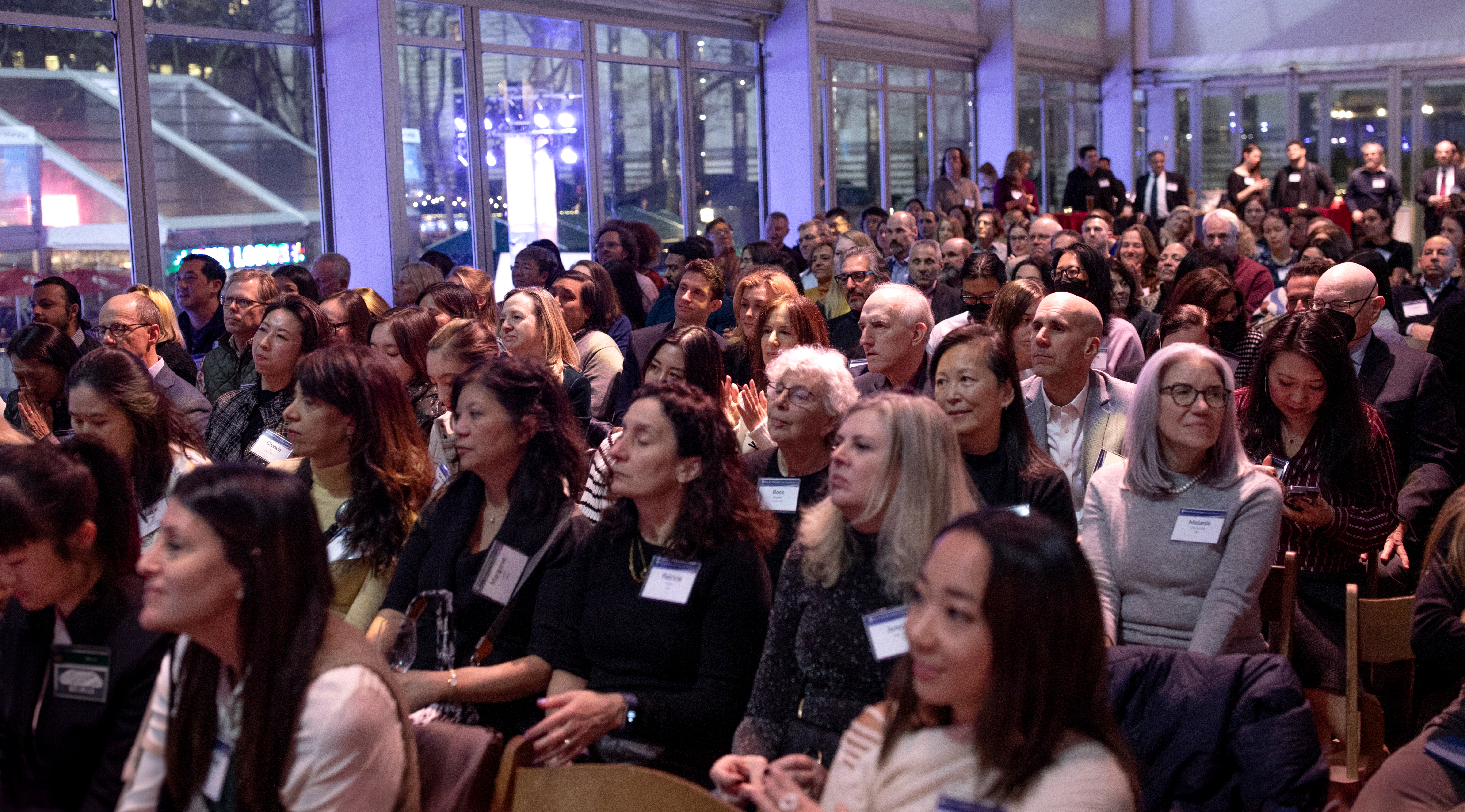On a brisk night in January overlooking the skating rink in New York’s Bryant Park, alumni took a journey from the depths of the sea to the outer reaches of space, as part of the annual Ben Talks NYC, a series that began nearly a decade ago.
This year’s event offered conversation from three Penn scientists on where the planet has been and where it’s going. Katie Barott, Assistant Professor of Biology, spoke about her research on coral reefs. Doug Jerolmack, Professor of Earth and Environmental Science and Mechanical Engineering and Applied Mechanics, focused on what happens in the places where land meets water or air. And Mark Trodden, Associate Dean for the Natural Sciences and Fay R. and Eugene L. Langberg Professor of Physics, spoke about the accelerating expansion of the universe.
Trodden also moderated the event, which began with an introduction from Dhan Pai, W’83, PAR’12, PAR’15, a member of Penn Arts & Sciences’ Board of Advisors, a University trustee, and one of the program hosts. “The School of Arts & Sciences is the focal point for understanding the changes in the world—scientific, political, historical, or otherwise. And the inquiry that happens within SAS allows us to better understand humanity, its role, and our impact on the world today,” he said. “Tonight, we’re actually going to cover the world … from the oceans to the land to space.”
Coral in Distress
First up, the oceans. For the past 10 or so years Barott has studied the biology and ecology of coral reef systems around Hawaii. “Coral reefs are the largest biologically built structures on our planet, and they’re just fascinating,” she began. Biodiversity from sharks to microorganisms depend on them for food and shelter, and novel chemical compounds found within the reefs have important potential medical uses. Lose the coral, she added, and the rest of it could go, too.
“Climate change has been a really huge problem and it’s been devastating coral reefs over the last several decades,” Barott said. “We’re seeing the seawater getting warmer globally. And in addition to average sea surface temperature increasing, we’re seeing an increase in the number of heat waves.”
Barott’s lab is working to understand precisely how this is affecting the coral, asking questions like why two corals next to each other—which have presumably experienced the same heat waves and seawater temperature fluctuations—are faring differently. What is causing one to bleach, for instance, and another to remain relatively healthy? How are they reproducing?
Barott ended her talk with a note of optimism and an image of herself next to a large coral on the Great Barrier Reef near Australia. “Climate change is having a really profound impact, threatening the survival of these ecosystems,” she said. “But there are still a ton of amazing corals and biodiversity left on reefs, so I have a lot of hope that corals can survive if we do something today.”
“Everything Is Fractured”
After Barott, Jerolmack took his turn. “When a geologist looks at planet Earth,” he said, “they strip away the ocean, they strip away all the life, they strip away all that stuff because of course, all of that is a thin little layer on the surface of a planet.” What he and scientists in his field home in on are the solid materials on the Earth’s surface. “What we see,” he added, “is that everything is fractured.”
The fractures aren’t random, however, but form patterns: T junctions when the cracks come together, X junctions when they cross. Continually stress materials with a few small cracks, and those join to create larger ones. “Consider mud cracks as a model system,” Jerolmack said. “The fractures appear somewhat random, but their geometry betrays an underlying order. In the beginning a few large cracks appear. Under continued drying, however, newer cracks connect to old ones and form telltale T junctions.”
Ice does something different, something special, he said. “If you crack ice, it’ll make a few long cracks, but if you keep cracking it, instead of making Ts, new cracks just run right over old cracks as if they weren’t there.” This happens because ice heals, whether from water dripping down from above or being pulled up from below, or even just from vapor deposited from the atmosphere. Because cracks heal, he added, sequential cracks run through them, and consequently, fractured ice forms conspicuous X junctions.
The signature of fracture mechanisms that are encoded in geometry can help to understand the fragility and resilience of glaciers and other materials on Earth and can reveal the role of water in shaping other planets like Mars, not only the presence of water, but even whether past environments cycled between wet and dry. “The idea now is that we can potentially map the habitability of worlds just by counting cracks,” Jerolmack said. “What drives us to explore other planets is a search for life, so we can ultimately understand who we are, where we came from, and under what conditions life emerges.”
A Universe Expanding
Finally, it was Trodden’s turn. “Tonight, I’m going to tell you three things about the universe,” he said.
Number one: it is expanding. “Galaxies are moving away from other galaxies, and it doesn’t take much imagination to realize that if you run that movie back in time, everything in the universe was closer to everything else in the past,” he said. At some point, it was all so close together that the universe was a “a hot, glowing, dense, heavy mass of matter and energy. That’s usually what we call the Big Bang.”
Secondly, less than a thousandth of a billionth of a nanosecond after the Big Bang, the universe expanded to “many times the size of our observable universe today,” a universe, he added, that today is very, very clumpy—his third point. “This introduces a vexing question for scientists: How come the universe, which started so smooth and hot and glowing, turned into something that clumped up in the way it did?”
We still don’t know for sure. What we do know is that this question will get answered by focusing on the tiniest things in our universe, not the largest. “What we think is happening … has very little to do with cosmology today,” Trodden concluded. “Rather, every structure you see in the universe has its origin as the tiniest little subatomic fluctuations at the earliest times in the universe. And that’s an amazing story.”
‘What Gives Each of You Hope?’
With that, Trodden opened up the floor to questions. The audience asked many, about alternative theories to the Big Bang, matter and anti-matter, whether it’s worth using geoengineering to save corals, what individuals can do to help heal the planet. Amber Knee, a 2014 graduate of Penn Design’s City Planning master’s program, asked the night’s final question.
“It can all feel a little bleak,” she said. “I’m interested in what gives each of you hope.”
Barott started. “These ecosystems are just moving. They’re beautiful, they’re fascinating, they’re dynamic, and I want my kids to be able to see them and experience the reefs that I’ve witnessed,” she said. “And these are long-lived ecosystems. They’ve survived many, many extinction events that others didn’t, so I have hope that in the long term, corals will survive … My hope lies in the fact that there are a lot of people who care very deeply about these systems.”
Jerolmack reiterated the sentiment. “The fact that so many of us are worried about this and recognize it and are focusing our intellectual and financial and social talents on this is something that no other group of humans has had the opportunity to do intentionally,” he said.
We also shouldn’t underestimate sheer human creativity, Trodden added. “My grandfather was born about a hundred years ago. Nothing I told you was known then. We didn’t even know there were other galaxies. There were just smudges on the sky,” he said. “I’m excited to be working on what I am now, and I just wish I could be around in another hundred years to see what we’ll know then.”
